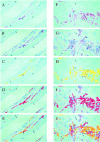Gastrointestinal stromal tumors may originate from a subset of CD34-positive interstitial cells of Cajal
- PMID: 10751339
- PMCID: PMC1876891
- DOI: 10.1016/S0002-9440(10)64984-X
Gastrointestinal stromal tumors may originate from a subset of CD34-positive interstitial cells of Cajal
Abstract
Most gastrointestinal stromal tumors (GISTs), a subgroup of mesenchymal neoplasms of the gut wall, express both Kit (CD117) and CD34 proteins. It has been suggested that GISTs originate from or differentiate into interstitial cells of Cajal (ICC), after several reports indicated that ICC are likely the only cells in the gut which express both Kit and CD34. ICC are among the few cell types resident in the gut which express Kit, together with mast cells. However, the question whether or not ICC express CD34 is currently disputed. Using single-cell reverse transcriptase-polymerase chain reaction (RT-PCR) on cultured murine intestinal cells, single ICC were selected by morphology and tested for the expression of c-kit and CD34 mRNA. Most ICC were only c-kit-positive, however a subset (7 out of 43) were double positive for both c-kit and CD34. In the human small intestine, sequential immunohistochemical staining for Kit and CD34 proteins on the same 3-microm sections showed that some of the ICC surrounding Auerbach's plexus and ICC within the circular muscle layer of the small intestine were positive for both Kit and CD34. In addition, CD34(+)Kit(-) cells were seen adjacent to ICC. These data from two different techniques indicate that ICC can be double positive for Kit and CD34. Thus, GISTs with the Kit(+)CD34(+) phenotype may arise from a subpopulation of CD34(+) Kit(+) ICC.
Figures


References
-
- Vanderwinden JM, Rumessen JJ, De Laet MH, Vanderhaeghen JJ, Schiffmann SN: CD34+ cells in human intestine are fibroblasts adjacent to, but distinct from, interstitial cells of Cajal. Lab Invest 1999, 79:59-65 - PubMed
-
- Editorial: Setting the pace for gastrointestinal stromal tumors. Lab Invest 1999, 79:1
-
- Saul SH, Rast ML, Brooks JJ: The immunohistochemistry of gastrointestinal stromal tumors: evidence supporting an origin from smooth muscle. Am J Surg Pathol 1987, 11:464-473 - PubMed
-
- Van de Rijn M, Hendrickson MR, Rouse RV: CD34 expression by gastrointestinal tract stromal tumors. Hum Pathol 1994, 25:766-771 - PubMed
Publication types
MeSH terms
Substances
LinkOut - more resources
Full Text Sources

